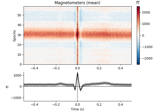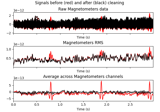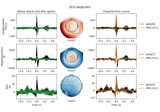mne.preprocessing.create_ecg_epochs#
- mne.preprocessing.create_ecg_epochs(raw, ch_name=None, event_id=999, picks=None, tmin=-0.5, tmax=0.5, l_freq=8, h_freq=16, reject=None, flat=None, baseline=None, preload=True, keep_ecg=False, reject_by_annotation=True, decim=1, verbose=None)[source]#
Conveniently generate epochs around ECG artifact events.
This function will:
Filter the ECG data channel.
Find ECG R wave peaks using
mne.preprocessing.find_ecg_events().Create
Epochsaround the R wave peaks, capturing the heartbeats.
Note
Filtering is only applied to the ECG channel while finding events. The resulting
ecg_epochswill have no filtering applied (i.e., have the same filter properties as the inputrawinstance).- Parameters:
- rawinstance of
Raw The raw data.
- ch_name
None|str The name of the channel to use for ECG peak detection. If
None(default), ECG channel is used if present. IfNoneand no ECG channel is present, a synthetic ECG channel is created from the cross-channel average. This synthetic channel can only be created from MEG channels.- event_id
int The index to assign to found ECG events.
- picks
str| array_like |slice|None Channels to include. Slices and lists of integers will be interpreted as channel indices. In lists, channel type strings (e.g.,
['meg', 'eeg']) will pick channels of those types, channel name strings (e.g.,['MEG0111', 'MEG2623']will pick the given channels. Can also be the string values “all” to pick all channels, or “data” to pick data channels. None (default) will pick all channels. Note that channels ininfo['bads']will be included if their names or indices are explicitly provided.- tmin
float Start time before event.
- tmax
float End time after event.
- l_freq
float Low pass frequency to apply to the ECG channel while finding events.
- h_freq
float High pass frequency to apply to the ECG channel while finding events.
- reject
dict|None Reject epochs based on maximum peak-to-peak signal amplitude (PTP), i.e. the absolute difference between the lowest and the highest signal value. In each individual epoch, the PTP is calculated for every channel. If the PTP of any one channel exceeds the rejection threshold, the respective epoch will be dropped.
The dictionary keys correspond to the different channel types; valid keys can be any channel type present in the object.
Example:
reject = dict(grad=4000e-13, # unit: T / m (gradiometers) mag=4e-12, # unit: T (magnetometers) eeg=40e-6, # unit: V (EEG channels) eog=250e-6 # unit: V (EOG channels) )
Note
Since rejection is based on a signal difference calculated for each channel separately, applying baseline correction does not affect the rejection procedure, as the difference will be preserved.
Note
To constrain the time period used for estimation of signal quality, pass the
reject_tminandreject_tmaxparameters.If
rejectisNone(default), no rejection is performed.- flat
dict|None Reject epochs based on minimum peak-to-peak signal amplitude (PTP). Valid keys can be any channel type present in the object. The values are floats that set the minimum acceptable PTP. If the PTP is smaller than this threshold, the epoch will be dropped. If
Nonethen no rejection is performed based on flatness of the signal.Note
To constrain the time period used for estimation of signal quality, pass the
reject_tminandreject_tmaxparameters.- baseline
None|tupleof length 2 The time interval to consider as “baseline” when applying baseline correction. If
None, do not apply baseline correction. If a tuple(a, b), the interval is betweenaandb(in seconds), including the endpoints. IfaisNone, the beginning of the data is used; and ifbisNone, it is set to the end of the data. If(None, None), the entire time interval is used.Note
The baseline
(a, b)includes both endpoints, i.e. all timepointstsuch thata <= t <= b.Correction is applied to each epoch and channel individually in the following way:
Calculate the mean signal of the baseline period.
Subtract this mean from the entire epoch.
- preloadbool
Preload epochs or not (default True). Must be True if keep_ecg is True.
- keep_ecgbool
When ECG is synthetically created (after picking), should it be added to the epochs? Must be False when synthetic channel is not used. Defaults to False.
- reject_by_annotationbool
Whether to reject based on annotations. If
True(default), epochs overlapping with segments whose description begins with'bad'are rejected. IfFalse, no rejection based on annotations is performed.New in v0.14.0.
- decim
int Factor by which to subsample the data.
Warning
Low-pass filtering is not performed, this simply selects every Nth sample (where N is the value passed to
decim), i.e., it compresses the signal (see Notes). If the data are not properly filtered, aliasing artifacts may occur.New in v0.21.0.
- verbosebool |
str|int|None Control verbosity of the logging output. If
None, use the default verbosity level. See the logging documentation andmne.verbose()for details. Should only be passed as a keyword argument.
- rawinstance of
- Returns:
- ecg_epochsinstance of
Epochs Data epoched around ECG R wave peaks.
- ecg_epochsinstance of
See also
Notes
If you already have a list of R-peak times, or want to compute R-peaks outside MNE-Python using a different algorithm, the recommended approach is to call the
Epochsconstructor directly, with your R-peaks formatted as an events array (here we also demonstrate the relevant default values):mne.Epochs(raw, r_peak_events_array, tmin=-0.5, tmax=0.5, baseline=None, preload=True, proj=False) # doctest: +SKIP


